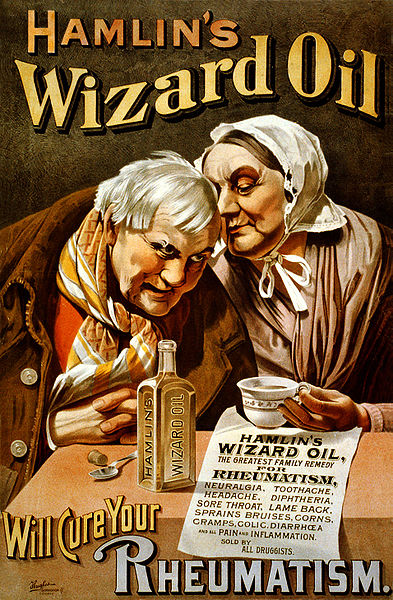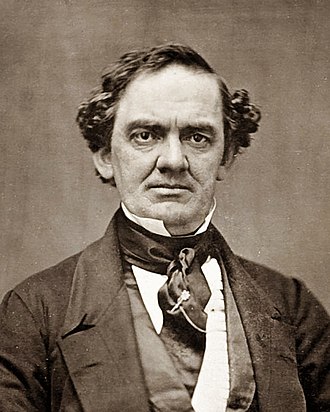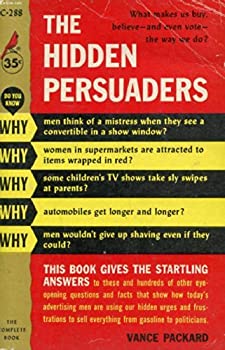Welcome to the second of what we’re calling Paleo Pellets: some occasional, shorter episodes explaining a particular topic. Our first one was on the DoubleClick ad server, and we thought we’d start this new year off with a look at what happened before DoubleClick.
That is the entire history of advertising up until about 1995. And I want to do this in 15 minutes or less.
So advertising, as we know it today, didn’t really exist until the late 19th century. I mean it existed, but it didn’t. It’s really striking – if you look at ads on posters or newspapers into the early 20th century – they are a lot more like a sign that says “Here I Am!” or “LOOK AT ME” rather than an ad.
The standard spot was five lines of text in a newspaper and advertisers and a single column and advertise. It just kept repeating their name over and over to fill up the space for their store or product. This style has a name: it’s called iteration advertising.

In terms of categories, creative advertising really started with awareness for quack remedies. These so-called patent medicines were very, very popular, pretty much totally unregulated, contained God knows what, but they made incredible claims. My favorite that I’ve seen is an ad for a pill called Hygiest that claimed that if you took it, “All would be well,” which would be amazing if it were true; it makes you wonder what was in it. But that is exactly by the way, what the 14th century mystic Julian of Norwich claimed about Christianity.

Another big early influencer was of course PT Barnum, who lived into the 1890s, and he innovated a lot of things to promote his museum in New York and his circus acts (and then also on the road). He started what we could call the cross-channel takeover campaign, where he would basically carpet bomb Manhattan on the same day.
So the flight started: he has his idea of a campaign with posters, handbills, flags, banners, marching bands, all announcing some act. And he had actually this very creative technique where he’d have a person, he would post a person somewhere on a street, looking at either his museum or one of his posters and then human nature being what it is, you know, people would pass this guy and say, ‘What are you looking at?’ So they would start looking too. And pretty soon there’d be a crowd looking, looking at his museum.
Barnum continued the patent medicine practice also making really false claims. Like one of his first exhibits he claimed was George Washington’s nurse and was 160 years old and so on when she was 80. And then when they did the autopsy, he actually promoted that as well and said, oh, she’s 80.
Barnum was a genius, of course. But I think in the long run, he probably hurt the image of marketing.
The dominant channels were out of home posters in cities and on some roads – and then of course print, so magazines and newspapers. And one problem that might sound familiar is how to aggregate a lot of local supply. So all the local players into audiences that could attract big buyers and bigger budgets, just make ad buying more efficient.
The first supply side brokers started to appear in the late nineties. They signed up a bunch of local publishers. They resold the inventory and added an unknown, what we would today call a black box markup. Now people back then didn’t like this markup, this unknown markup any more than they like it now. So a guy named Francis Ayer decided to compete on what he actually called transparency.

Believe it or not, he took a flat 15% markup on the media and that 15%, by the way, remained standard. That’s the standard take rate until very recently. He started doing it back in the 1870s.
There were other non-media related developments that helped the industry.
One was the growth of department stores. There was Stewart’s in New York, which doesn’t exist anymore. Macy’s and then in Philadelphia Wanamaker’s. And they had a lot of stuff to sell, so more categories and they had, these categories-makers who were prolific advertisers of mass market products. They had to convince people that they needed them first, and then they needed to differentiate from the competitors.
And these were things like sewing machines and household products and typewriters, bicycles, off the rack clothing, even. And they had to create demand for these.
Another development that affected everything was the railroad, of course, which created more cities. And more local media in the cities, as well as it created the ground for the mail order catalog, which was definitely the Amazon of its day.
At its peak I think the Sears catalog and Montgomery Ward’s were about five or 600 pages and they had, you know, thousands of different products and these products all needed to distinguish themselves and gain awareness, through local and national newspaper magazine ads. And the Sears catalog itself actually became a major advertiser for itself.
Now the idea of a brand, which we got from the cattle industry, was a way to differentiate products that were commodities. It started with patent medicines, of course, which were pretty much all branded and tobacco. So we’ll say things that are not good for you. Convincing you to use things that are not good for you.
And then by the 1910s, we start to see fictional characters like Mr. Peanut say, or the Morton salt girl who are a humanization of what are basically the most generic commodities you can imagine: peanuts and salt.
And the ad industry grew very fast. According to Ad Age magazine, it went from about 500 million total spending to 3 billion in the first two decades of the 20th century.
Academics started to take an interest in this new field. Theories of persuasion were written. Psychology was brought into the picture. Agency people started to appear acting like they knew what they were talking about, and they knew how to tell, convince people to buy whatever it was.
And then what we would call the grammar of modern ads was figured out. There were two theories. One was that ads are assessed rationally and have to present an argument to buy. So this is the so-called “reason why” ads, understandably. An example, which was championed by Claude Hopkins, who was a proponent of this approach, was an ad for Pepsodent – which is a toothpaste – presented the “single selling point,” which in the case of Pepsodent – it was whiter teeth.

Another popular theory was the so-called “soft sell,” which focused on how the product would make the buyer feel.
So what is the impact on them and on their lifestyle and on their family? This was championed by one of the first ad actual ad psychologists, a guy named Walter Dill Scott. An example would be early ads for Cadillac, for “Wherever the noble and the admirable congregate,” which is interesting. And they also talked about creating a “Cadillac Home.”
Starting in the thirties and forties, we get into more modern media like radio. but before we go there I’d like to mention a couple of things that surprised me about this earlier period, when I was researching it.
The first is that business people – the ad buyers – did not really seem to naturally want to advertise. It’s a learned behavior; publications and brokers had to talk them into it. In fact, the natural inclination in the early decades was to see advertising as low class and kind of desperate as an admission of defeat.
Ironically, by the way – because today, most of us know him for the maybe apocryphal quote, you know, half my, I don’t know which half of my ad spending is wasted that quote – John Wanamaker of the Philadelphia department store fame and a copywriter that he found a guy named John Powers: those two guys did more than anyone to prove to their competitors and other potential advertisers that advertising really worked.
They were the gold standard.
Second thing that surprised me was that consumer’s attitudes toward advertising have always been pretty darn mixed. There is a quote I like from a trade man called Printers’ Ink from a hundred years ago. It goes: “The family circle is not a public place. And advertising has no business intruding there unless it is invited.”
So when radio gets popular in the thirties is another familiar problem: Who’s going to pay for the content? Nobody seemed to know in the beginning. The first commercial programs were what we would call now wall-to-wall infomercials. So totally brand sponsored content, and it was repeated over and over.
The first station in New York, which was owned by AT&T, ran and reran and reran a program created by and sponsored by a real estate company. This got dull for everyone pretty fast. So the model that eventually worked was developed by ad agencies, these growing agencies, they would create shows around entertainers that were solely sponsored by one of the agencies’ bigger brands.

So for example, we have the Y&R agency, they had a client Jell-O, they went to Jack Benny, proposed the show, developed the Jack Benny radio program that was sponsored by and heavily featuring Jell-O.
This sole sponsor model works really well. It really does from a listener’s perspective, from everyone’s perspective. If you don’t believe me, listen to radio programs from the golden age in the 1940s, like the Lux Radio Theater.
You hear a big stars like Clark Gable say in Product placements throughout the show here and there, you know, that are, that are recognizable and then little fictional scenes, occasional cutaway to a fictional scene about where someone will talk about moisturizing with a Lux.
Lux was a soap, Lux flakes. They’ve definitely raised awareness for the product, these flakes. And it’s not, it’s not annoying actually, because it’s totally transparent. And I think this method would work really well in the metaverse and I’m not actually kidding.
The sole sponsor agency led model persisted into the sixties until basically until TV and especially color made the cost of content creation so incredibly high that no single sponsor could pay for a program. They just didn’t want to. And that in turn helped make agencies less powerful. And that led to the modern model that we have now, where networks pay for content and distribution, advertisers and agencies just buy little pieces of attention.
And meanwhile, the impact of regulators on the ad business did not start with GDPR, CCPA. Even pre TV – so back in the forties, this is be the, you know, post FDR era – the FCC decided it didn’t like concentrated media ownership. So studios and networks were actually broken up. Aggressively. So for example, part of NBC radio network was sold to the LifeSavers mogul, Edward Noble, and he turned around and created ABC.
Then the 1950s, there was cold war paranoia about motivation research and even subliminal advertising. There was this sort of fear of subliminal ads. And there was a very popular book called the Hidden Persuaders by Vance Packard, which claimed advertisers were trying to manipulate us without our knowledge, by putting little messages in the ads.

In fact I really don’t think they were.
But it was the development for the first time in the 1960s of relatively immersive, full color, sometimes even real-time medium, like broadcast or linear television; sight-sound-and-motion along with really attractive, full color magazines, slightly more inclusive society with definitely rising standard of living for many, not all – all this led to the golden age of better media planning, more creative style, a confident advertising professional, more open-minded clients (sometimes) …
This was the era of David Ogilvy and the Marlboro man. And in terms of the look and feel of it, moving into the sixties, there’s a shift to kind of image or lifestyle that the product promises on average with a lot of exceptions.
Then in the seventies, there’s actually a push for more of the so-called positioning spots. So we saw Coke versus Pepsi or the UnCola, a category defined by what it’s not. And the creation of Lite versions of things, which are also defined by what they don’t have, what they’re missing. And all of this seems to be a function of too many brands. Let’s face it, it’s turning a so-called bug into a feature, but also very creative and clever.

And then in the eighties, the big story was probably the explosion of cable channels, which is a preview of the infinite media options we’ve got today. And on the agency side, massive roll-up of agencies into bigger and bigger holding companies, global holding companies that live mainly I think, to fight with media sources about pricing.
And then out of absolutely nowhere in 1989 a British guy named Tim Berners Lee invents the worldwide web on top of a very obscure academic military network called the internet, which nobody had heard of. And a couple of kids at the University of Illinois, Marc Andreessen and Eric Bina, along with some of their friends, invent the Mosaic browser and then go west and create Netscape and so on.
And pretty soon we’re in the real world of paleo ad tech.
So thanks for joining me. I’d like to end on a slightly positive. Advertising executives were cited as the least trusted profession, according to a Gallup poll released back in 1976. But just last year, a similar poll found that ad workers are no longer the least trusted profession. We have finally been out mistrusted by politicians.
Happy New Year!
